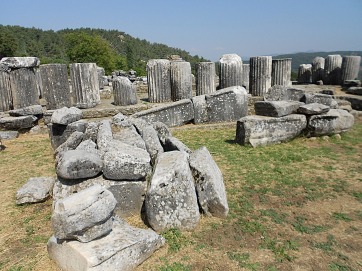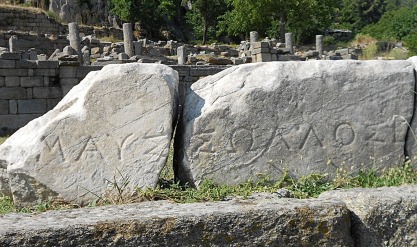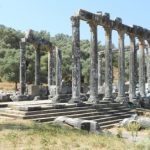The hillside ruins of Labranda lie northwest of Milas (Mylasa) in beautiful wooded countryside but are only accessible via a road in a shockingly bad state of repair.
Labranda bore the same sort of relationship to Mylasa (Milas) as Didyma did to Miletus or Lagina to Stratonikeia. In other words it was a religious settlement rather than a town and here you’ll find the underwhelming remnants of a Temple to Zeus in his warlike aspect as the axe-bearer (Labrandus) along with massive rooms that seem to have been used for celebrations. Originally Labranda was linked to Milas by a 12km-long Sacred Way, along which a procession would pass on a yearly basis (some parts of it are still visible). Important meetings of the Carian League and its later reincarnation, the Chrysaoric League, also seem to have been held here.
Hard though it may be to imagine it, a battle was actually fought on what is now a grassy terrace in 497 BC. At the end of it the Carians and their Miletians allies had been defeated by the Persians.
Most of the grand-but-austere structures on the site date back to the fourth century B.C.
Two of the four “androns”, which appear to have been meeting places or banqueting halls for men, probably with some sort of religious character, cannot be missed. The first was dedicated to Idrieus (r.351-44) , brother of King Mausolus of Halikarnassos (modern Bodrum) and his successor as king, the second to Mausolus (r. 377-52) himself whose name can be seen in Greek lettering in an inscription on the site. Most of the building work appears to have taken place after 355 BC when Mausolus survived an assassination attempt here.  Not much remains of the great Temple of Zeus
Not much remains of the great Temple of Zeus
A fine tomb also survives from the fourth century B.C. although to climb up to it would not be easy.
According to Pliny, Labranda was the site of a fish oracle where people came to be told their fate. The priests would throw food to the necklace and earring-wearing fish — if they ate it, the answer was yes, if they rejected it, the answer was no.
The site appears to have been abandoned after a fire in the 4th century AD.
Transport info
Labranda is on the road from Milas to Karpuzlu (Alında) but it is in a shocking condition and isn’t served by any buses (the state of the road is the result of a never-ending stream of lorries carrying away sand from a nearby quarry). You really need decent wheels to keep going past Labranda to Alında.
Without your own car you will need to hire a taxi in Milas (15km) to visit the site. Then you could get yourself dropped off at Beçin Kalesi or Euromos on the way back to make the most of the trip.
An hour is as long as you will need here.
 Mausolus’ name appears in Greek lettering in this inscription
Mausolus’ name appears in Greek lettering in this inscription


